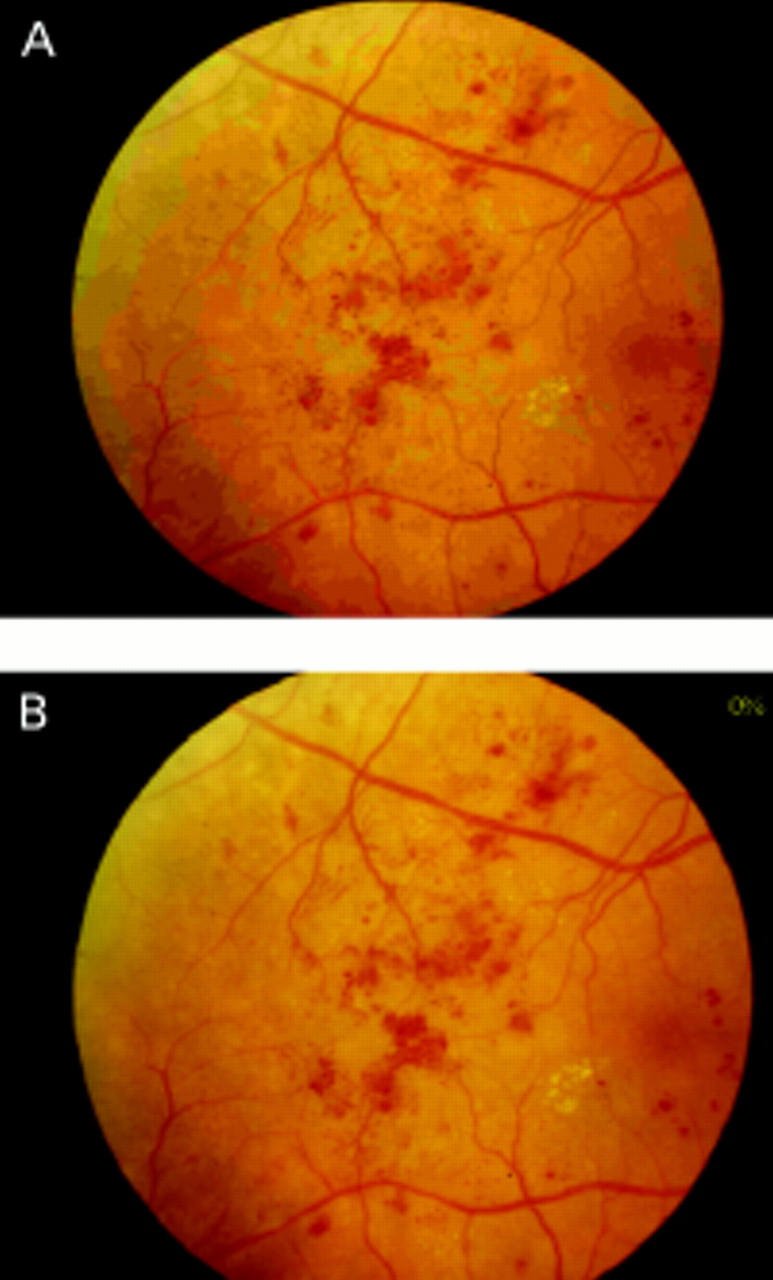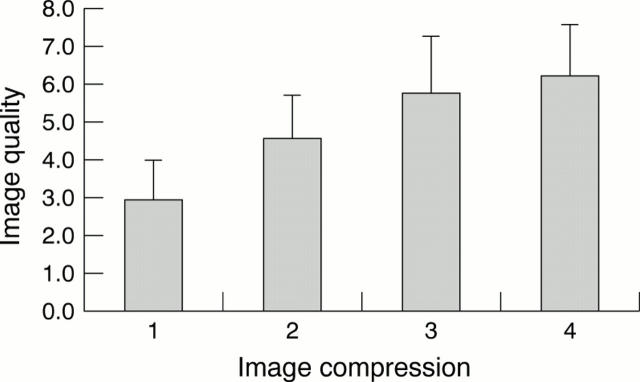Abstract
BACKGROUND/AIMS—Digital imaging is widely used for diabetic retinopathy screening. The storage and transmission of digital images can be facilitated by image compression. The authors aimed to assess the effect of image compression on the accuracy of grading diabetic retinopathy. METHODS—Forty nine 35 mm transparencies (17 with no retinopathy, eight with background, five with preproliferative, and 19 with proliferative retinopathy) were digitised and subjected to JPEG compression by 90%, 80%, 70%, and 0%. The 196 images were randomised and graded on a portable computer. Two masked graders assessed the images for grade of retinopathy and image quality (0-10). The sensitivity and specificity of retinopathy grading were calculated with a weighted kappa for grading agreement between levels of compression. RESULTS—The sensitivity of retinopathy grading was reduced by JPEG compression. At 90%, 80%, 70%, and 0% compression the sensitivities were 0.38, 0.50, 0.65, and 0.72, respectively; the specificity results were 1.00, 1.00, 0.83, and 0.84, respectively; and the weighted kappa scores were 0.60, 0.75, 0.77, and 0.84, respectively. The quality scores for 90%, 80%, 70%, 0% compression were 2.9 (SD 1.1, 95% CI; 2.7-3.2), 4.6 (SD 1.1, 95% CI; 3.0-5.6), 5.8 (SD1.5, 95% CI 5.0-6.6), 6.3 (SD1.4, 95% CI; 5.4-7.2) (p<0.01 for each intergroup comparison). CONCLUSION—The results demonstrate significant loss of sensitivity to the features of diabetic retinopathy with JPEG compression; this was compounded by the thin film transistor (TFT) screen. The authors found the quality of uncompressed images on TFT screens too poor to give grading sensitivities which reach current guidelines for diabetic retinopathy screening.
Full Text
The Full Text of this article is available as a PDF (125.2 KB).
Figure 1 .

Image compression showing the effect of image compression on an image with proliferative retinopathy. (A) 90% compression: note colour blocking, increased granularity, with loss of intraretinal microvascular abnormalities, microaneurysms, and neovascularisation. (B) 0% compression: showing good retinal detail, fine details clear on image.
Figure 2 .
Change in image quality with degree of image compression (p<0.01 for each intergroup comparison).
Selected References
These references are in PubMed. This may not be the complete list of references from this article.
- Browning G. C., Liang Y., Buckwalter K. A., Kruger R. A., Aisen A. World Wide Web interface to digital imaging and communication in medicine-capable image servers. J Digit Imaging. 1996 Nov;9(4):178–184. doi: 10.1007/BF03168616. [DOI] [PubMed] [Google Scholar]
- Cree M. J., Olson J. A., McHardy K. C., Sharp P. F., Forrester J. V. A fully automated comparative microaneurysm digital detection system. Eye (Lond) 1997;11(Pt 5):622–628. doi: 10.1038/eye.1997.166. [DOI] [PubMed] [Google Scholar]
- Gardner G. G., Keating D., Williamson T. H., Elliott A. T. Automatic detection of diabetic retinopathy using an artificial neural network: a screening tool. Br J Ophthalmol. 1996 Nov;80(11):940–944. doi: 10.1136/bjo.80.11.940. [DOI] [PMC free article] [PubMed] [Google Scholar]
- George L. D., Halliwell M., Hill R., Aldington S. J., Lusty J., Dunstan F., Owens D. R. A comparison of digital retinal images and 35 mm colour transparencies in detecting and grading diabetic retinopathy. Diabet Med. 1998 Mar;15(3):250–253. doi: 10.1002/(SICI)1096-9136(199803)15:3<250::AID-DIA565>3.0.CO;2-G. [DOI] [PubMed] [Google Scholar]
- George L. D., Leverton C., Young S., Lusty J., Dunstan F. D., Owens D. R. Can digitised colour 35 mm transparencies be used to diagnose diabetic retinopathy? Diabet Med. 1997 Nov;14(11):970–973. doi: 10.1002/(SICI)1096-9136(199711)14:11<970::AID-DIA484>3.0.CO;2-Y. [DOI] [PubMed] [Google Scholar]
- George L. D., Lusty J., Owens D. R., Ollerton R. L. Effect of software manipulation (Photoshop) of digitised retinal images on the grading of diabetic retinopathy. Br J Ophthalmol. 1999 Aug;83(8):911–913. doi: 10.1136/bjo.83.8.911. [DOI] [PMC free article] [PubMed] [Google Scholar]
- Iyriboz T. A., Zukoski M. J., Hopper K. D., Stagg P. L. A comparison of wavelet and Joint Photographic Experts Group lossy compression methods applied to medical images. J Digit Imaging. 1999 May;12(2 Suppl 1):14–17. doi: 10.1007/BF03168745. [DOI] [PMC free article] [PubMed] [Google Scholar]
- Jensen P. K., Scherfig E. Resolution of retinal digital colour images. Acta Ophthalmol Scand. 1999 Oct;77(5):526–529. doi: 10.1034/j.1600-0420.1999.770508.x. [DOI] [PubMed] [Google Scholar]
- Kerr D., Cavan D. A., Jennings B., Dunnington C., Gold D., Crick M. Beyond retinal screening: digital imaging in the assessment and follow-up of patients with diabetic retinopathy. Diabet Med. 1998 Oct;15(10):878–882. doi: 10.1002/(SICI)1096-9136(199810)15:10<878::AID-DIA686>3.0.CO;2-3. [DOI] [PubMed] [Google Scholar]
- Kivijärvi J., Ojala T., Kaukoranta T., Kuba A., Nyúl L., Nevalainen O. A comparison of lossless compression methods for medical images. Comput Med Imaging Graph. 1998 Jul-Aug;22(4):323–339. doi: 10.1016/s0895-6111(98)00042-1. [DOI] [PubMed] [Google Scholar]
- Lazzaro J., Wawrzynek J. JPEG quality transcoding using neural networks trained with a perceptual error measure. Neural Comput. 1999 Jan 1;11(1):267–296. doi: 10.1162/089976699300016917. [DOI] [PubMed] [Google Scholar]
- Lee P. Telemedicine: opportunities and challenges for the remote care of diabetic retinopathy. Arch Ophthalmol. 1999 Dec;117(12):1639–1640. doi: 10.1001/archopht.117.12.1639. [DOI] [PubMed] [Google Scholar]
- Oka A., Harima Y., Nakano Y., Tanaka Y., Watanabe A., Kihara H., Sawada S. Interhospital network system using the worldwide web and the common gateway interface. J Digit Imaging. 1999 May;12(2 Suppl 1):205–207. doi: 10.1007/BF03168804. [DOI] [PMC free article] [PubMed] [Google Scholar]
- Ricke J., Maass P., Lopez Hänninen E., Liebig T., Amthauer H., Stroszczynski C., Schauer W., Boskamp T., Wolf M. Wavelet versus JPEG (Joint Photographic Expert Group) and fractal compression. Impact on the detection of low-contrast details in computed radiographs. Invest Radiol. 1998 Aug;33(8):456–463. doi: 10.1097/00004424-199808000-00006. [DOI] [PubMed] [Google Scholar]
- Ryder R. E., Kong N., Bates A. S., Sim J., Welch J., Kritzinger E. E. Instant electronic imaging systems are superior to Polaroid at detecting sight-threatening diabetic retinopathy. Diabet Med. 1998 Mar;15(3):254–258. doi: 10.1002/(SICI)1096-9136(199803)15:3<254::AID-DIA543>3.0.CO;2-C. [DOI] [PubMed] [Google Scholar]
- Sinthanayothin C., Boyce J. F., Cook H. L., Williamson T. H. Automated localisation of the optic disc, fovea, and retinal blood vessels from digital colour fundus images. Br J Ophthalmol. 1999 Aug;83(8):902–910. doi: 10.1136/bjo.83.8.902. [DOI] [PMC free article] [PubMed] [Google Scholar]
- Taylor D. J., Fisher J., Jacob J., Tooke J. E. The use of digital cameras in a mobile retinal screening environment. Diabet Med. 1999 Aug;16(8):680–686. doi: 10.1046/j.1464-5491.1999.00139.x. [DOI] [PubMed] [Google Scholar]
- Undrill P. Towards the automatic interpretation of retinal images. Br J Ophthalmol. 1996 Nov;80(11):937–938. doi: 10.1136/bjo.80.11.937. [DOI] [PMC free article] [PubMed] [Google Scholar]
- Yogesan K., Constable I. J., Eikelboom R. H., van Saarloos P. P. Tele-ophthalmic screening using digital imaging devices. Aust N Z J Ophthalmol. 1998 May;26 (Suppl 1):S9–11. doi: 10.1111/j.1442-9071.1998.tb01385.x. [DOI] [PubMed] [Google Scholar]



